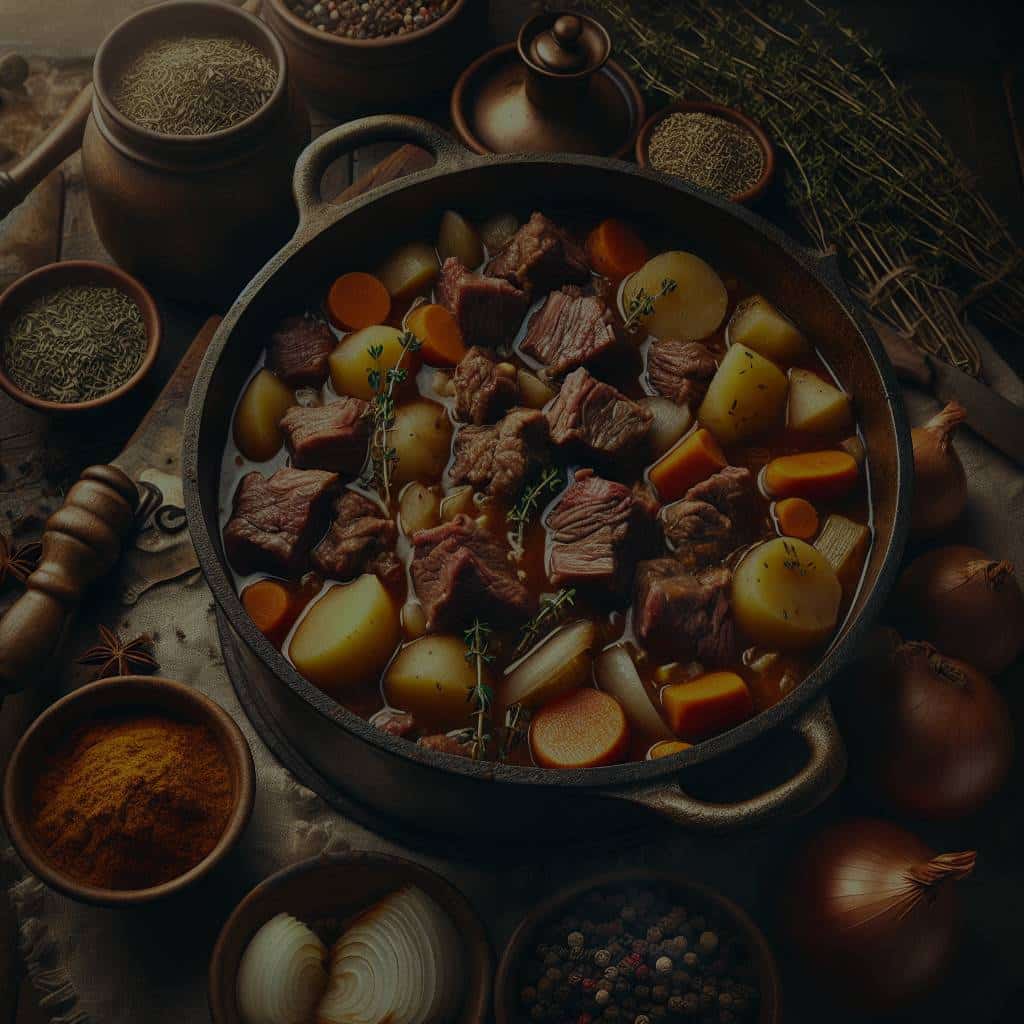What Techniques Can You Use to Make a Rich and Hearty Irish Lamb Stew?

A hearty Irish Lamb Stew is a delightful blend of savory lamb, fresh vegetables, and a deeply satisfying broth. The charm of this dish is in its simplicity, highlighting the flavors of its primary ingredients without relying on a host of spices or complicated procedures. The secret to cooking this vibrant Irish dish is in the techniques you use, the quality of your ingredients, and the time you allow for it to simmer and develop its flavors. Lets delve into the key techniques to make this classic Irish dish.
Choosing and Preparing the Ingredients
A good Irish stew starts with the right ingredients. The starring ingredient, of course, is the lamb. Good quality lamb will ensure your stew is flavorful and tender.
Also to discover : How to Bake a Gourmet Key Lime Pie with a Buttery Graham Cracker Crust?
When choosing lamb, look for cuts that are rich in connective tissue, such as the neck or shoulder. These cuts might take longer to cook, but the connective tissue breaks down during the cooking process, adding a velvety thickness to the stew. Cut your lamb into 2-inch cubes to ensure it cooks evenly.
Potatoes are another key ingredient in an Irish stew. Look for waxy potatoes like Yukon Gold or Red Bliss. These potatoes hold their shape during the long simmering process and add a satisfying chunkiness to the stew.
Also to discover : What’s the Best Way to Prepare a Flavorful Cajun Jambalaya with Andouille Sausage?
Fresh vegetables are essential. Traditional Irish lamb stew includes carrots and onions, but feel free to add other root vegetables according to your taste. Cut your vegetables into large chunks as they will shrink during cooking.
Browning the Meat
Browning the meat is one of the most important steps in making a rich and hearty stew. This is where the magic happens. The process of browning, also known as the Maillard reaction, creates a deep, savory flavor that will infuse the entire stew.
Start by patting the lamb dry with a paper towel. Wet meat won’t brown properly. Then, season it generously with salt and pepper. Heat a large pot or Dutch oven over medium-high heat and add a couple of tablespoons of fat — bacon fat or olive oil work well. Add the lamb to the pot in batches, being careful not to overcrowd the pot. Turn the pieces until they are browned on all sides. Remove the browned lamb and set aside.
Making the Broth
This is where your stew really starts to come together. Once you’ve removed the browned meat, add your chopped onions to the pot. Cook them until they are soft and golden, about 5 minutes. Then, add a couple of tablespoons of flour. Stir it into the onions and let it cook for a couple of minutes. This will help thicken your stew.
Next, deglaze the pot with a generous splash of Guinness. This Irish stout not only adds flavor, but also helps lift those delicious browned bits from the bottom of the pot. Let the Guinness simmer for a few minutes to reduce slightly before adding your meat back into the pot, along with your cut vegetables.
Pour in enough beef or chicken broth to cover the ingredients by an inch or so. The broth will reduce as your stew simmers, so don’t be tempted to add too much. A quality broth will add another layer of flavor to your stew.
The Slow Simmer
Once your stew is assembled, it’s time for the slow simmer. This is where patience really pays off. Lower the heat, cover your pot, and let the stew simmer gently for at least 2 hours. This slow cooking process allows the flavors to meld together and the lamb to become meltingly tender.
Check the stew occasionally, giving it a gentle stir to make sure nothing is sticking to the bottom of the pot. If the stew seems too thick, you can add a bit more broth. Taste the stew as it cooks and adjust the seasoning if necessary.
Adding the Final Touches
When your stew is nearly finished, add in your cubed potatoes. These should simmer until they are just tender, about 20 minutes. Adding them later in the cooking process ensures they maintain their shape and don’t disintegrate into the stew.
For a final touch of freshness, add in a handful of chopped fresh parsley. The bright flavor and vibrant color of the parsley provide a nice contrast to the rich, hearty flavors of the stew.
In conclusion, making a rich and hearty Irish lamb stew is all about the techniques you use and the time you allow for the flavors to develop. Choose quality ingredients, brown your meat thoroughly, make a flavorful broth, simmer slowly and patiently, and finish with fresh touches. With these techniques, you can create a lamb stew that is truly worthy of any Irish celebration.
Utilizing Different Cooking Methods
There is more than one way to prepare a rich and hearty Irish lamb stew. While the traditional method involves slow cooking on a stove top, modern kitchen appliances like the slow cooker and Instant Pot can also yield delicious results.
Using a slow cooker is an excellent way to prepare your stew, especially if you are looking to minimize active cooking time. Simply brown your lamb and onions in a skillet, then transfer them to the slow cooker along with the other ingredients. Set the slow cooker to low and let your stew cook for about 8 hours.
An Instant Pot is another great tool for stew-making. It has a sauté function for browning your meat and onions, then you can simply add the remaining ingredients and switch to pressure cooking mode. The pressure cooker will significantly reduce the cooking time, allowing your stew to be ready in about an hour.
Regardless of your chosen cooking method, remember to use a Dutch oven or a heavy-bottomed pot if you are cooking on the stove. These pots distribute heat evenly, ensuring that your lamb is cooked perfectly and that the flavors are well incorporated.
The Role of Additional Flavors
While the lamb meat, vegetables, and broth form the base of your stew, additional ingredients can enhance and deepen the flavors. Ingredients like fresh thyme, red wine, bay leaf, and a mixture of onions and garlic can be used to add more complexity to your stew.
Fresh thyme is a traditional herb used in Irish cuisine, and it pairs beautifully with lamb. Add a few sprigs to your pot for a subtle, earthy flavor.
A splash of red wine can add richness and depth to your stew. It can be used in addition to, or instead of, the Guinness. Be sure to let it simmer to allow the alcohol to cook off, leaving behind a robust flavor.
Adding a bay leaf is a simple way to add another layer of flavor. It imparts a subtle, slightly sweet flavor that complements the other ingredients nicely.
Sautéing a mix of onions and garlic in the fat left behind from browning the meat can create a flavorful base for your stew. This mixture will form a significant part of the stew’s aroma and taste.
Conclusion: Perfecting Your Stew Recipe
In the final analysis, the making of an authentic Irish lamb stew is much more than following a recipe. It’s about understanding how the ingredients work together, knowing how to coax out their flavors, and having the patience to let the dish slowly cook to perfection.
Remember to choose a good quality lamb shoulder or neck, brown the stew meat thoroughly to bring out the savory flavors, and deglaze the pot to incorporate the flavorful brown bits into the stew. Fresh vegetables, a homemade beef broth, and key aromatic ingredients like thyme, bay leaf, and a mixture of onions and garlic further enhance the taste.
Whether you are preparing it for a quiet family dinner or a grand St. Patrick’s Day celebration, a well-made Irish lamb stew is sure to satisfy. And remember, like a fine wine, a good stew always tastes better the next day when the flavors have had more time to meld together. So, don’t hesitate to make your Irish lamb stew a day in advance to achieve the best flavor profile. Happy cooking!
